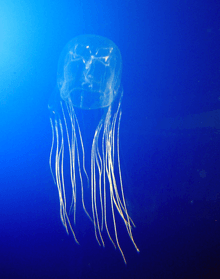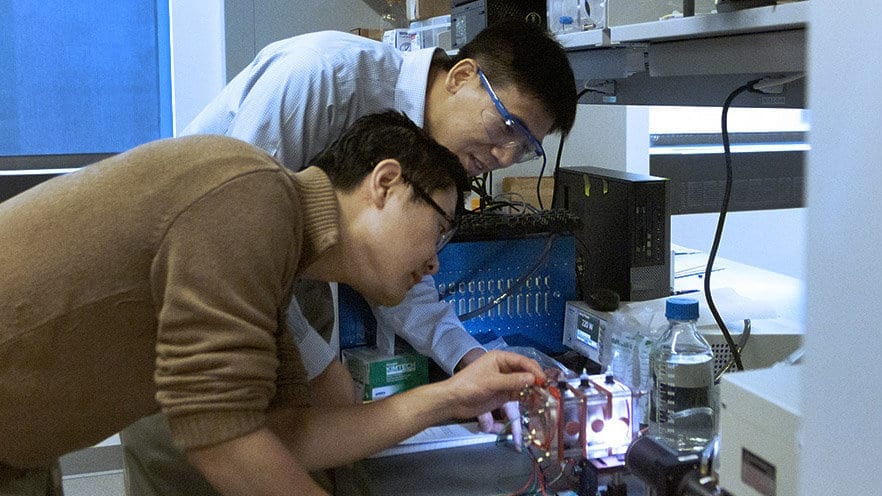
A team of pain researchers in the Charles Perkins Centre studied the most venomous creature on earth to learn how venom works and what causes pain. Researchers at the University of Sydney have discovered an antidote to the deadly sting delivered by the most venomous creature on earth – the Australian box jellyfish.
The Australian box jellyfish (Chironex fleckeri) has about 60 tentacles that can grow up to three metres long. Each tentacle has millions of microscopic hooks filled with venom.
Each box jellyfish carries enough venom to kill more than 60 humans.
A single sting to a human will cause necrosis of the skin, excruciating pain and, if the dose of venom is large enough, cardiac arrest and death within minutes.
Associate Professor Greg Neely and Dr Raymond (Man-Tat) Lau and their team of pain researchers at the Charles Perkins Centre were studying how the box jellyfish venom works when they made the discovery.
They uncovered a medicine that blocks the symptoms of a box jellyfish sting if administered to the skin within 15 minutes after contact.
The antidote was shown to work on human cells outside the body and then tested effectively on live mice. Researchers now hope to develop a topical application for humans.
“We were looking at how the venom works, to try to better understand how it causes pain. Using new CRISPR genome editing techniques we could quickly identify how this venom kills human cells. Luckily, there was already a drug that could act on the pathway the venom uses to kill cells, and when we tried this drug as a venom antidote on mice, we found it could block the tissue scarring and pain related to jellyfish stings,” said Associate Professor Neely. “It is super exciting.”
Published in the prestigious journal Nature Communications, the study used CRISPR whole genome editing to identify how the venom works. Genome editing is a technology that allows scientists to add, remove or alter genetic material in an organism’s DNA.
In the study, the researchers took a vat of millions of human cells and knocked out a different human gene in each one. Then they added the box jellyfish venom – which kills cells at high doses – and looked for cells that survived. From the whole genome screening, the researchers identified human factors that are required for the venom to work.
“The jellyfish venom pathway we identified in this study requires cholesterol, and since there are lots of drugs available that target cholesterol, we could try to block this pathway to see how this impacted venom activity. We took one of those drugs, which we know is safe for human use, and we used it against the venom, and it worked,” said Dr Lau, who is the lead author on the paper. “It’s a molecular antidote.”
“It’s the first molecular dissection of how this type of venom works, and possible how any venom works,” Dr Lau said. “I haven’t seen a study like this for any other venom.”
“We know the drug will stop the necrosis, skin scarring and the pain completely when applied to the skin,” said Associate Professor Neely, who is the senior author on the paper. “We don’t know yet if it will stop a heart attack. That will need more research and we are applying for funding to continue this work.”
Learn more: Pain researchers find antidote to deadly box jellyfish sting
The Latest on: Box jellyfish
[google_news title=”” keyword=”box jellyfish” num_posts=”10″ blurb_length=”0″ show_thumb=”left”]
via Google News
The Latest on: Box jellyfish
- 5 Creatures To Beware Of When Swimming In The Hawaiian Waterson April 30, 2024 at 4:15 am
However, you don't have to be a surfer to get injured in the waters of Hawaii. Even for swimmers and snorkelers, it is easy to underestimate the strength of the waves and not consider what types of ...
- British tourist dies from jellyfish stingon April 25, 2024 at 5:00 pm
Translucent Irukandji jellyfish are a tiny relative of the lethal box jellyfish which has killed about 65 people in Australia over the last 50 years. Australia has hundreds of types of jellyfish ...
- Scientists call for caution as deadly box jellyfish found off Penang’s coaston April 24, 2024 at 5:00 pm
GEORGE TOWN: Two species of the deadly box jellyfish, previously not thought to exist here, are breeding in the sea around Penang. Their venom causes Irukandji Syndrome, which includes severe ...
- 11 Types Of Jellyfish, Ranked By Danger Levelon April 21, 2024 at 6:00 am
Jellyfish are both stunning and fascinating creatures. That said, some of them can also be quite lethal. Here are 11 types of jellyfish, ranked by danger level.
- Magnetic Island: Woman suffers marine sting from Irukandji jellyfish at Horseshoe Bayon April 14, 2024 at 1:14 pm
A young woman has suffered a reported marine sting on Magnetic Island. A young woman has suffered a reported marine sting on Magnetic Island. Queensland Ambulance Service confirmed that a 25-year-old ...
- Lifesaver urges north Queensland swimmers to wear stinger suits as deadly box jellyfish wash upon April 12, 2024 at 6:00 am
But as beach numbers surged over the school holidays, surf life saving volunteers have spotted waves of "very large and lethal" box jellyfish washing up along the shore. "I keep telling people ...
- How Cairns doctor Jack Barnes discovered Irukandji jellyfish by stinging himself and his 10-year-old sonon April 1, 2024 at 6:13 am
Sloshing around inside was a never-before-seen creature. A tiny jellyfish — the size of a thumbnail — with a box-shaped bell and four tentacles. After years of detective work, Dr Barnes was ...
- Jellyfish: The smart stinging creatures drifting through our oceanson March 29, 2024 at 3:42 am
Most are free-swimming species with the characteristic bell-shaped body, also called a medusa. Cubozoans are more commonly known as box jellyfish. They differ from scyphozoan jellyfish because of ...
- All Aboardon November 4, 2023 at 10:30 pm
Jorgen Rasmussen (Singapore) frames an intriguing interaction between a box jellyfish, a fish and an argonaut. Under the cover of darkness, millions of zooplankton migrate up from the depths of the ...
- A Caribbean box jellyfish (IMAGE)on September 22, 2023 at 8:01 am
Disclaimer: AAAS and EurekAlert! are not responsible for the accuracy of news releases posted to EurekAlert! by contributing institutions or for the use of any information through the EurekAlert ...
via Bing News










